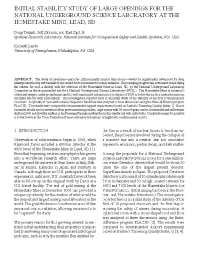Mining Publication: Initial Stability Study of Large Openings for the National Underground Science Laboratory at the Homestake Mine, Lead, SD
Original creation date: July 2002
Authors: DR Tesarik, JC Johnson, RK Zipf, K Lande
NIOSHTIC2 Number: 20030441
NARMS-TAC 2002: Mining and Tunnelling Innovation and Opportunity, Proceedings of the 5th American Rock Mechanics Symposium and the 17th Tunnelling Association of Canada Conference, July 7-10, 2002, Toronto, Ontario, Canada. R. Hammah, W. Bawden, J. Curran, and M. Telesnicki, eds., Toronto, Ontario, Canada, University of Toronto Press, 2002 Jul; 1:157-163
The study of neutrinos - particles infinitesimally smaller than atoms - would be significantly advanced if a deep underground facility were available that would filter out unwanted cosmic radiation. Encouraging progress has been made in satisfying the criteria for such a facility with the selection of the Homestake Mine in Lead, SD, by the National Underground Laboratory Committee as the recommended site for a National Underground Science Laboratory (NUSL). The Homestake Mine is America's oldest and deepest underground mine, and its well-maintained infrastructure to depths of 2438 m below the surface makes the mine an excellent site for such a laboratory. The investigation reported here is an initial study of the stability of the first of the proposed chambers. A cylindrical room with a dome-shaped roof and floor was analyzed in three dimensions using the finite-difference program FLAC3D. The results were compared to recommended support requirements based on Barton's Tunneling Quality Index, Q. Based on model results and observations from previous mining studies, large rooms with 50-m roof spans can be constructed and will remain stable at 2141 m below the surface in the Poorman Formation when the rock is reinforced with cable bolts. Construction may be possible at lower levels in the Yates Formation if more extensive laboratory strength tests confirm initial results.

NIOSHTIC2 Number: 20030441
NARMS-TAC 2002: Mining and Tunnelling Innovation and Opportunity, Proceedings of the 5th American Rock Mechanics Symposium and the 17th Tunnelling Association of Canada Conference, July 7-10, 2002, Toronto, Ontario, Canada. R. Hammah, W. Bawden, J. Curran, and M. Telesnicki, eds., Toronto, Ontario, Canada, University of Toronto Press, 2002 Jul; 1:157-163
- Computer Simulation of Ground Behaviour and Rock Bolt Interaction at Emerald Mine
- Determination of In Situ Deformation Modulus for Cemented Rockfill
- Ground Monitoring
- Ground Stress in Mining (Part 1): Measurements and Observations at Two Western U.S. Longwall Mines
- Ground Stress in Mining (Part 2): Calibrating and Verifying Longwall Stress Models
- Horizontal Stress
- Numerical Model Calibration for Simulating Coal Pillars, Gob and Overburden Response
- Proceedings: New Technology for Ground Control in Multiple-seam Mining
- Roof Monitoring in Limestone - Experience with the Roof Monitoring Safety System (RMSS)
- Technical Solutions for Enhancements to Mine Safety Using Barricade II Fire Blocking Gel